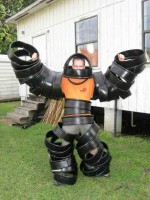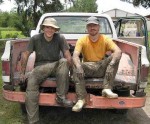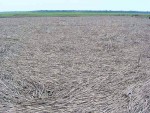*Personal Experience*
It has been ten years since I first saw the Georgia coastal ecosystems - as a visiting scientist at the University of Georgia Marine Institute (UGAMI), Sapelo Island. Two years earlier, I had met my host, Steve Pennings, at the Bamfield Marine Station (now: Bamfield Marine Sciences Centre). During my two months' stay at Sapelo, we worked together on the decomposition of saltmarsh detritus of different origin through the action of different saltmarsh detritivores, finally confirming interspecific differences in the contributions of various detritivore species to the decomposition of various common species of detritus in saltmarshes.
One of our most fascinating results (at least to me) was our discovery that the saltmarsh crab, Armases cinereum, was an omnivore that fed not only on detritus but also on detritivores. Consequently, we suggested that this crab acted as a vector of saltmarsh-derived nutrients to the coastal forests (and vice versa), but were unable at the time to provide strong evidence for this hypothesis.
The experience of being introduced into this fascinating marine-terrestrial ecotone by Steve Pennings, Tracy Buck, and Steve Newell was my inauguration into saltmarsh ecology. Since then, I have been intrigued by the very special beauty and atmosphere of the Georgia saltmarshes, particularly compared to European saltmarshes that are way more diverse in terms of vegetation, but less species-rich in terms of the potentially detritivorous macro-fauna. Looking back, I can say that I spent two precious months at a wonderful place, getting to know many nice and helpful people.
Back in Kiel, it took me some time to establish a saltmarsh team of my own, but I finally managed to transfer my fascination to some of my students. The first was Malte Mews, who studied the role of detritivore and detritus diversity in decomposition processes in ring-shaped field mesocosms in a variety of habitats. On Sapelo Island, he carried out a long-term decomposition study in situ that he set up together with Sebastian Fraune (a Diploma student of mine: photo "slightly dirty") in June and terminated in September 2006. The major outcome of that particular study was a surprise to us (and contradicted previous findings both from other habitat types and from Sapelo Island): deritivores other than the periwinkle, Littoraria irrorata, had little influence on decomposition processes in the upper saltmarsh.
More recently, in 2007, I gathered five students to spend two months on Sapelo Island to study the detritivorous soil fauna and their contribution to decomposition processes along a habitat gradient, from the aquatic to the terrestrial environment. Their stay on Sapelo resulted from my association since 2005 with GCE-LTER, and was supervised by Steve Pennings.
In 2008 one of the students, Franziska Seer, who had worked with Gregor Putze and Yuri Zablotski on Sapelo in 2007, came back to collect a second set of samples from a long-term (24 months) decomposition study. We are still analyzing the corresponding data, but our results already show that detritus-specific differences in decomposition rates are, in the long run, overruled by habitat-specific processes; and that at no time during the long-term process do macro-detritivores significantly affect decomposition.
The last set of litter bags of this long-term field study are currently being recovered from the field by Christine Ewers. Christine had been working with Anika Beiersdorf and Kazik Wieski since 2007 on the effects of predator/prey-interactions--the previously mentioned crab (Armases), the periwinkle (Littoraria), and the coffee bean snail (Melampus bidentatus)--on the decomposition of low-quality detrital subsidies from coastal forests into the upper saltmarsh. The captivating results suggest a positive joint effect of omnivorous crabs and detritivorous snails on the decomposition of, and nutrient release from, low-quality detritus.
This particular project influenced my current research within GCE-LTER, which focuses on the wharf crab, Armases cinereum. My diploma student Lena Hübner spent her summer 2009 at UGAMI on Sapelo Island to re-assess the feeding ecology of this so-called saltmarsh crab in detail. She did this both in the field through a capture/re-capture approach and occasional behavioural observations and in the lab through the comparative analysis of the morphology of feeding appendages, feeding preferences, the activity of various digestive enzymes, the composition of gut microbiota, the stable isotope signatures of crabs, and potential food sources. Already, we can show that the woods rather than the saltmarsh are home to this important key player in saltmarsh decomposition processes and nutrient fluxes.
In the European saltmarshes, my diploma student Philipp Eereveld and my Master of Science student Lena Kempener are currently working on the effects of the detritivorous fauna on the decomposition of a formerly wide-spread saltmarsh cord grass (Spartina anglica) and the currently spreading couch grass Elytrigia atherica. They are also investigating how these interactions are affected by saltmarsh predators, particularly lycosid spiders, through both field and lab decomposition studies in combination with PCR and stable isotope-based analyses of predator/prey interactions.
Another major aspect of saltmarsh ecology is currently covered by my PhD student, Ulf Evert: how will the predicted increase in frequency and severity of storm events, in combination with increased plant biomass as a result of eutrophication of coastal waters, translate into the thickness of detrital mats (photo: “Spartina wrack at Sapelo”)? To-date, we have strong evidence of a reduction of dicotyledonous plants in favour of monocots upon addition of increasing detrital mass. However, even grasses are inhibited by the detritus and its leachates; it seems that the physical effect of covering and shading the soil promotes growth of the saltmarsh grasses.
Although the corresponding studies have thus far been based in German saltmarshes, we have a strong link with GCE-LTER that will, hopefully, result in continuing collaboration between our group and people from Sapelo Island. We hope to become involved in the recently implemented continental-scale network for studying the effects of windstorms on coastal ecosystems, and to spend time and conduct research on Sapelo. Ultimately, we hope this so far one-sided collaboration–not counting a visit by Steve Pennings and, later, his group to my lab—will expand to become a true exchange program with funding opportunities for student research.
References
Buck TL, Breed GA, Pennings SC, Chase ME, Zimmer M, Carefoot TH. 2003. Diet choice in an omnivorous salt marsh crab: different food types, body size and habitat complexity. J Exp Mar Biol Ecol 292: 103-116.
Ewers C, Beiersdorf A, Wieski K, Pennings SC, Zimmer M. in review. Intra-guild predator/prey-interactions promote decomposition of low-quality detritus.
Hopkinson CS, Lugo AE, Alber M, Covich A, van Bloem S. 2008. Understanding and forecasting the effects of sea level rise and intense windstorms on coastal and upland ecosystems: the need for a continental-scale network of observatories. Frontiers in Ecology and Environment 6:255-263.
Seer F, Zimmer M. in prep. Habitat-specific decomposition rates of terrestrial detritus along a marine-terrestrial gradient.
Treplin M, Zimmer M. in prep. Detrital origin, but not detritivore action, controls decomposition of angiosperm detritus in the upper saltmarsh.
Zimmer M, Pennings SC, Buck TL, Carefoot TH. 2002. Species-specific patterns of litter processing by terrestrial isopods (Isopoda: Oniscidea) in high intertidal salt marshes and coastal forests. Funct Ecol 16: 596-607.
Zimmer M, Pennings SC, Buck TL, Carefoot TH. 2004. Salt marsh litter and detritivores: a closer look at redundancy. Estuaries 27: 753-769.
Martin Zimmer is with Christian-Albrechts-Universität zu Kiel, Germany.

 Enlarge this image
Enlarge this image

